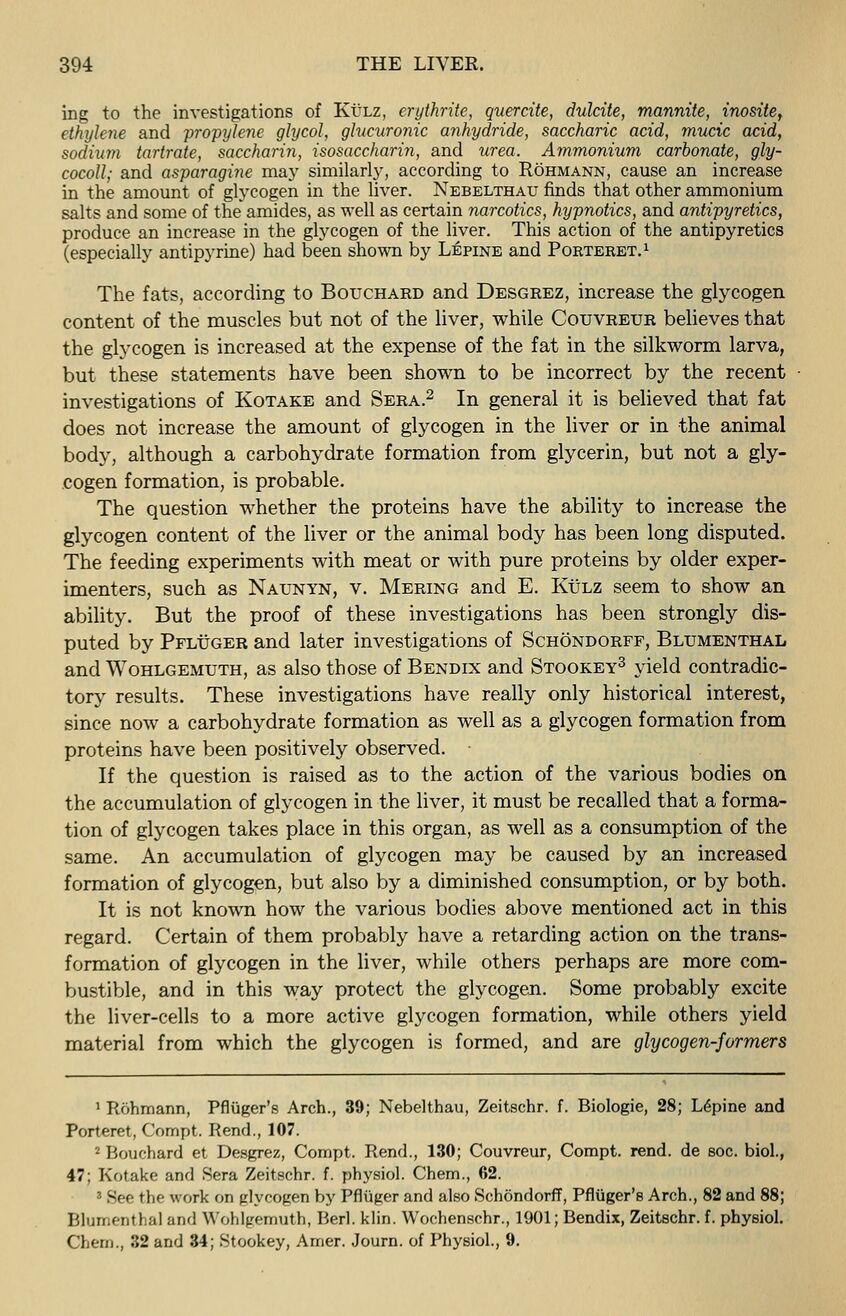
Full resolution (JPEG) - On this page / på denna sida - VII. The Liver - Glycogen and its Formation

<< prev. page << föreg. sida << >> nästa sida >> next page >>
Below is the raw OCR text
from the above scanned image.
Do you see an error? Proofread the page now!
Här nedan syns maskintolkade texten från faksimilbilden ovan.
Ser du något fel? Korrekturläs sidan nu!
This page has never been proofread. / Denna sida har aldrig korrekturlästs.
394 THE LIVER.
ing to the investigations of Kulz, erythrite, quercite, dulcite, mannite, inosite,
ethylene and propylene glycol, glucuronic anhydride, saccharic acid, mucic acid,
sodium tartrate, saccharin, isosaccharin, and urea. Ammonium carbonate, gly-
cocoll; and asparagine may similarly, according to Rohmann, cause an increase
in the amount of glycogen in the liver. Nebelthau finds that other ammonium
salts and some of the amides, as well as certain narcotics, hypnotics, and antipyretics,
produce an increase in the glycogen of the liver. This action of the antipyretics
(especially antipyrine) had been shown by Lepine and Porteret. 1
The fats, according to Bouchard and Desgrez, increase the glycogen
content of the muscles but not of the liver, while Cotjvreur believes that
the glycogen is increased at the expense of the fat in the silkworm larva,
but these statements have been shown to be incorrect by the recent
investigations of Kotake and Sera.2
In general it is believed that fat
does not increase the amount of glycogen in the liver or in the animal
body, although a carbohydrate formation from glycerin, but not a gly-
cogen formation, is probable.
The question whether the proteins have the ability to increase the
glycogen content of the liver or the animal body has been long disputed.
The feeding experiments with meat or with pure proteins by older exper-
imenters, such as Naunyn, v. Mering and E. Kulz seem to show an
ability. But the proof of these investigations has been strongly dis-
puted by Pfluger and later investigations of Schondorff, Blumenthal
and Wohlgemuth, as also those of Bendix and Stookey3 yield contradic-
tory results. These investigations have really only historical interest,
since now a carbohydrate formation as well as a glycogen formation from
proteins have been positively observed.
If the question is raised as to the action of the various bodies on
the accumulation of glycogen in the liver, it must be recalled that a forma-
tion of glycogen takes place in this organ, as well as a consumption of the
same. An accumulation of glycogen may be caused by an increased
formation of glycogen, but also by a diminished consumption, or by both.
It is not known how the various bodies above mentioned act in this
regard. Certain of them probably have a retarding action on the trans-
formation of glycogen in the liver, while others perhaps are more com-
bustible, and in this way protect the glycogen. Some probably excite
the liver-cells to a more active glycogen formation, while others yield
material from which the glycogen is formed, and are glycogen-formers
1
Rohmann, Pfliiger’s Arch., 39; Nebelthau, Zeitschr. f. Biologie, 28; Lepine and
Porteret, Compt. Rend., 107.
2
Bouchard et Desgrez, Compt. Rend., 130; Couvreur, Compt. rend, de soc. biol.,
47; Kotake and Sera Zeitschr. f. physiol. Chem., 62.
Bee the work on glycogen by Pfluger and also Schondorff, Pfliiger’s Arch., 82 and 88;
Blumenthal and Wohlgemuth, Berl. klin. Wochenschr., 1901; Bendix, Zeitschr. f. physiol.
Chem., 32 and 34; Stookey, Amer. Journ. of Physiol., 9.
<< prev. page << föreg. sida << >> nästa sida >> next page >>